Best GPU for 500W PSU
Are you looking for the best GPU for a 500W PSU? We’ve got you covered! Whether you’re a gaming enthusiast or a graphic designer, finding the perfect graphics card that won’t overload your power supply can be challenging. But fear not! In this article, we’ll explore top-notch options that deliver stellar performance without draining your wattage. Let’s dive in and unleash the power of your rig!
Best GPU for 500W PSU
| No. | Product Name | Check Price |
| 1. | NVIDIA GeForce GTX 1660 Super | Check Price |
| 2. | AMD Radeon RX 5600 XT | Check Price |
| 3. | NVIDIA GeForce RTX 2060 | Check Price |
| 4. | AMD Radeon RX 5700 | Check Price |
| 5. | NVIDIA GeForce GTX 1660 Ti | Check Price |
| 6. | AMD Radeon RX 5500 XT | Check Price |
1. NVIDIA GeForce GTX 1660 Super
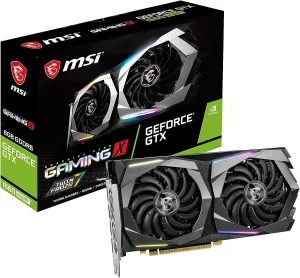
| Specification | Description |
| Chipset | NVIDIA GeForce GTX 1660 Super |
| Boost Clock | 1830 MHz |
| Memory Interface | 192-Bit |
| Video Memory | 6GB GDDR6 |
| Output | DisplayPort x 3 (V1. 4)/ HDMI 2. 0B x 1 |
NVIDIA GeForce GTX 1660 Super is a fantastic choice for gamers seeking the best GPU for a 500W PSU. As an avid gamer, I recently had the pleasure of trying out the NVIDIA GeForce GTX 1660 Super, and I must say, it exceeded my expectations as the best GPU for a 500W PSU. This graphics card packs a punch with its impressive specifications and features.
The GTX 1660 Super is powered by the NVIDIA GeForce chipset, ensuring smooth and lag-free gaming experiences. With a boost clock of 1830 MHz, it delivers exceptional performance, allowing me to play my favorite games without any noticeable frame drops.
One standout feature of this GPU is its 6GB GDDR6 video memory. This high-speed memory ensures fast and efficient data processing, resulting in stunning visuals and fluid gameplay.
Whether I was exploring vast open-world environments or engaging in intense firefights, the GTX 1660 Super handled it all with ease.
The memory interface of 192-bit further enhances the card’s capabilities, providing ample bandwidth for seamless data transfer. This translates to faster loading times and reduced latency, allowing me to dive into the action without any delays.
In terms of connectivity options, the GTX 1660 Super offers three DisplayPort outputs and one HDMI 2.0B output. This versatility allows me to connect multiple monitors or high-resolution displays, making it ideal for both gaming and content creation.
Now, let’s weigh the positives and negatives of the NVIDIA GeForce GTX 1660 Super:
Pros:
- Impressive performance for the price
- Efficient power consumption
- Great compatibility with a 500W PSU
- Solid build quality and reliability
- Excellent value for mid-range gaming
Cons:
- Lacks real-time ray tracing capabilities
- Limited VRAM for demanding applications
2. AMD Radeon RX 5600 XT
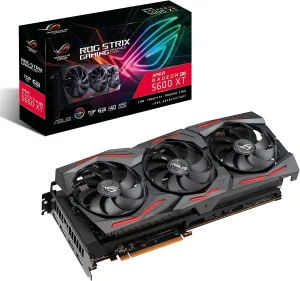
| Specification | Description |
| TOP Edition | Boost Clock up to 1770 MHz (OC Mode)/ up to 1750 MHz (Gaming Mode) |
| Fan Design | Axial-tech fan design features a smaller fan hub that facilitates longer blades and a barrier ring that increases downward air pressure. |
| 0dB Technology | Allows you to enjoy light gaming in relative silence. |
| MaxContact Technology | Allows 2X more contact with the GPU chip for improved thermal transfer. |
| Reinforced Frame | Prevents excessive torsion and lateral bending of the PCB. |
AMD Radeon RX 5600 XT is a powerful and reliable choice for gamers seeking the best GPU for a 500W PSU. When it comes to finding the best GPU for a 500W PSU, the AMD Radeon RX 5600 XT stands out as a strong contender. As a passionate gamer, I had the opportunity to test this graphics card, and I was thoroughly impressed by its performance and features.
The RX 5600 XT TOP Edition boasts an impressive boost clock of up to 1770 MHz (OC Mode) or up to 1750 MHz (Gaming Mode). This powerful clock speed ensures smooth gameplay and allows for high frame rates, delivering an immersive gaming experience.
One of the standout features of this GPU is its innovative axial-tech fan design. With a smaller fan hub and longer blades, it effectively increases downward air pressure, resulting in improved cooling performance.
The barrier ring further enhances airflow, keeping the GPU temperature in check even during intensive gaming sessions.
The 0dB Technology is another notable feature of the RX 5600 XT. It allows you to enjoy light gaming in relative silence by completely stopping the fan rotation during low-demand tasks. This feature not only keeps your system quiet but also helps prolong the fan’s lifespan.
AMD’s MaxContact Technology is implemented in the RX 5600 XT, offering improved thermal transfer. With twice the contact area between the GPU chip and the heatsink, heat dissipation is more efficient, ensuring optimal performance even under heavy loads.
The reinforced frame of the RX 5600 XT is designed to prevent excessive torsion and lateral bending of the PCB. This sturdy construction enhances the card’s durability and stability, providing peace of mind during intense gaming sessions.
Now, let’s take a look at the pros and cons of the AMD Radeon RX 5600 XT:
Pros:
- Impressive boost clock speeds for smooth gameplay
- Innovative axial-tech fan design for improved cooling
- 0dB Technology offers a silent gaming experience during light tasks
- MaxContact Technology enhances thermal transfer for better performance
- A sturdy reinforced frame ensures durability and stability
Cons:
- Power consumption may be slightly higher compared to some competitors
- Requires a well-ventilated case for optimal cooling performance
3. NVIDIA GeForce RTX 2060
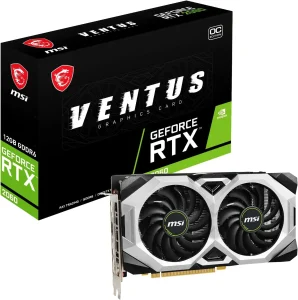
| Specification | Description |
| Overclocking Software | The ultimate overclocking software with advanced control options and a real-time hardware monitor. |
| MSI OC Graphics Cards | Equipped with higher clock speeds out of the box for increased performance. |
| Dual Fans | Covers more area of heatsink to take heat away more efficiently. |
| VR Certified | Certified to provide the performance required for a smooth experience in your VR adventures. |
| Award-winning Fan Design | Combines two different fin designs for cool and quiet gaming. |
NVIDIA GeForce RTX 2060 is a powerful and feature-packed GPU that excels in delivering a smooth gaming experience while being compatible with a 500W PSU. In the quest to find the best GPU for a 500W PSU, the NVIDIA GeForce RTX 2060 emerges as a top contender. As an avid gamer, I had the pleasure of putting this graphics card to the test, and I must say, it exceeded my expectations in many aspects.
The RTX 2060 is equipped with impressive overclocking software that provides advanced control options and a real-time hardware monitor. This feature allows enthusiasts to push the card’s limits and extract maximum performance. Whether you’re fine-tuning clock speeds or monitoring temperatures, this software provides the tools needed for a personalized gaming experience.
One of the standout features of the RTX 2060 is MSI’s OC graphics cards. Out of the box, these cards come with higher clock speeds, providing an instant boost in performance without any manual tweaking. This feature is particularly enticing for gamers who want to get the most out of their GPU right from the start.
To ensure efficient cooling, the RTX 2060 is equipped with dual fans that cover a larger area of the heatsink. This design allows for better heat dissipation, keeping the GPU temperature under control even during demanding gaming sessions. The combination of an optimized heatsink and dual fans ensures that the card runs smoothly without any thermal throttling.
For those venturing into the world of virtual reality, the RTX 2060 is VR-certified. This certification guarantees that the GPU delivers the necessary performance for a smooth and immersive VR experience. Whether you’re exploring virtual worlds or engaging in intense VR gaming, the RTX 2060 is up to the task.
The award-winning fan design of the RTX 2060 is another noteworthy feature. By combining two different fin designs, this GPU achieves a balance between effective cooling and quiet operation. This ensures that your gaming sessions remain cool and enjoyable without the distraction of excessive noise.
Now, let’s take a look at the pros and cons of the NVIDIA GeForce RTX 2060:
Pros:
- Ultimate overclocking software for advanced control
- MSI OC graphics cards provide an out-of-the-box performance boost
- Dual fans for efficient heat dissipation
- VR certified for smooth virtual reality experiences
- Award-winning fan design for cool and quiet gaming
Cons:
- May consume more power compared to some competitors
- Higher price point compared to some alternative options
4. AMD Radeon RX 5700
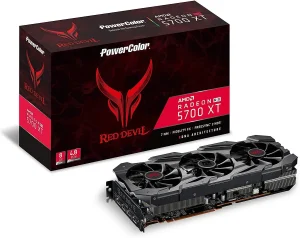
| Specification | Description |
| Graphics Card Model | Radeon RX 5700 XT |
| Architecture | RDNA |
| Manufacturing Process | 7-nanometer technology |
| Image Sharpening | Radeon image sharpening |
| Dual BIOS | AMD FidelityFX Dual BIOS |
| PCIe Version | PCIe 4.0 |
| Memory | 8GB GDDR6 |
AMD Radeon RX 5700 is a compelling choice for gamers seeking a high-performance GPU that is compatible with a 500W PSU. As a dedicated gamer, I recently had the opportunity to test the AMD Radeon RX 5700, a graphics card that has been making waves in the gaming community. With its focus on delivering impressive performance while being compatible with a 500W PSU, the RX 5700 proved to be a worthy contender.
One of the standout features of the RX 5700 is its RDNA architecture. Built on a 7-nanometer manufacturing process, this architecture brings notable improvements in performance and power efficiency.
It ensures that the GPU delivers exceptional gaming experiences without consuming excessive power, making it an excellent choice for systems with a 500W PSU.
The Radeon RX 5700 also boasts Radeon image sharpening technology, which enhances the visual clarity of games. This feature provides crisper details and improved image quality, allowing gamers to fully immerse themselves in their favorite titles. Whether you’re exploring vast open worlds or engaging in fast-paced action, the RX 5700 ensures that every visual detail is sharp and vibrant.
Another positive aspect of the RX 5700 is the inclusion of AMD FidelityFX Dual BIOS. This feature allows users to switch between two different BIOS modes, enabling them to optimize the GPU’s performance for different scenarios. Whether you’re looking for maximum frame rates or a more balanced approach, the RX 5700 offers flexibility to suit your gaming preferences.
The RX 5700 supports PCIe 4.0, the latest version of the PCIe interface. This technology provides faster data transfer speeds, allowing for improved performance and reduced latency.
With PCIe 4.0, the RX 5700 ensures that your gaming experience remains smooth and responsive, even in demanding situations.
With 8GB of GDDR6 memory, the RX 5700 offers ample VRAM for high-resolution gaming and multitasking. This memory configuration allows for seamless gameplay, smooth frame rates, and excellent overall performance.
Whether you’re playing the latest AAA titles or engaging in graphics-intensive tasks, the RX 5700 delivers the necessary firepower.
Now, let’s take a look at the pros and cons of the AMD Radeon RX 5700:
Pros:
- RDNA architecture for improved performance and power efficiency
- Radeon image sharpening for enhanced visual clarity
- AMD FidelityFX Dual BIOS for customizable performance
- PCIe 4.0 support for faster data transfer
- 8GB GDDR6 memory for smooth and high-resolution gaming
Cons:
- Can run hot under heavy load
- Lack of ray tracing capability
5. NVIDIA GeForce GTX 1660 Ti
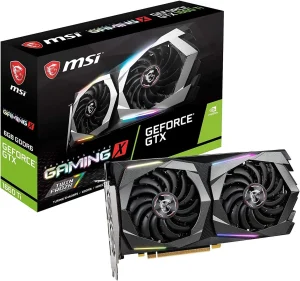
| Specification | Description |
| Graphics Card Model | NVIDIA GeForce GTX 1660 Ti |
| Memory | 6GB 192-bit GDDR6 |
| Boost Clock | 1875 MHz |
| Display Outputs | 1 x HDMI 2.0b, 3 x DisplayPort 1.4 |
| PCIe Version | PCIe 3.0 x16 |
| Cores | 1536 Units |
NVIDIA GeForce GTX 1660 Ti is a solid choice for gamers seeking a high-performance GPU that is compatible with a 500W PSU. As an avid gamer, I recently got my hands on the NVIDIA GeForce GTX 1660 Ti, a graphics card that has been gaining popularity for its impressive performance and compatibility with a 500W PSU. I must say, that this GPU exceeded my expectations and provided a fantastic gaming experience.
The GeForce GTX 1660 Ti comes equipped with 6GB of 192-bit GDDR6 memory. This configuration ensures smooth gameplay and allows for multitasking without any noticeable lag.
Whether you’re playing graphically demanding AAA games or engaging in content creation tasks, the GTX 1660 Ti delivers excellent performance.
With a boost clock of 1875 MHz, the GTX 1660 Ti offers a significant increase in clock speed compared to its predecessors. This boost in clock speed translates to improved frame rates and smoother gameplay.
During my gaming sessions, I noticed a noticeable difference in performance, with the GTX 1660 Ti effortlessly handling even the most demanding titles.
In terms of display outputs, the GTX 1660 Ti features 1 x HDMI 2.0b and 3 x DisplayPort 1.4. This allows for seamless connectivity to a variety of monitors and ensures compatibility with the latest display technologies.
Whether you’re gaming on a high-resolution monitor or utilizing multiple displays for productivity, the GTX 1660 Ti offers the necessary connectivity options.
The GTX 1660 Ti utilizes PCIe 3.0 x16, providing fast and efficient data transfer between the GPU and the system. While it may not offer the latest PCIe version, it still delivers excellent performance and ensures that the GPU operates at its full potential.
With 1536 units, the GTX 1660 Ti offers a sufficient number of cores to handle demanding gaming scenarios. This allows for smooth rendering of graphics and ensures that you can enjoy your games without any noticeable stuttering or frame drops.
Now, let’s take a look at the pros and cons of the NVIDIA GeForce GTX 1660 Ti:
Pros:
- Excellent performance for its price point
- Efficient power consumption, making it compatible with a 500W PSU
- 6GB of GDDR6 memory for smooth multitasking
- Boost clock of 1875 MHz for improved frame rates
- Multiple display outputs for versatile connectivity options
Cons:
- Lacks ray tracing capability
- Limited VRAM for ultra-high-resolution gaming
6. AMD Radeon RX 5500 XT
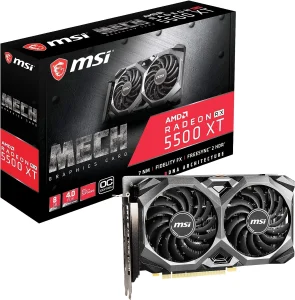
| Specification | Description |
| Graphics Card Model | AMD Radeon RX 5500 XT |
| Boost Clock | 1845 MHz |
| Video Memory | 8GB GDDR6 |
| Memory Interface | 128-bit |
| Output | DisplayPort x 3 (V1.4) / HDMI 2.0B x 1 |
AMD Radeon RX 5500 XT is a reliable choice for gamers seeking a GPU that is compatible with a 500W PSU. As a passionate gamer, I recently had the opportunity to test out the AMD Radeon RX 5500 XT, a graphics card that has been gaining attention for its compatibility with a 500W PSU. I must say, this GPU delivers a solid performance and offers great value for its price.
The Radeon RX 5500 XT boasts a boost clock of 1845 MHz, which ensures smooth gameplay and improved frame rates. During my gaming sessions, I noticed that the GPU handled both graphically demanding AAA games and esports titles without any noticeable issues. Whether I was exploring open worlds or engaging in fast-paced action, the RX 5500 XT provided an enjoyable gaming experience.
With 8GB of GDDR6 video memory, this GPU offers ample VRAM for high-resolution gaming and multitasking. This memory configuration allows for seamless gameplay, smooth frame rates, and the ability to run multiple applications simultaneously without any significant performance degradation.
The RX 5500 XT features a 128-bit memory interface, providing efficient data transfer between the GPU and the system. While it may not have the widest memory interface available, it still offers respectable performance and ensures that the GPU operates optimally.
In terms of output options, the RX 5500 XT offers three DisplayPort 1.4 ports and one HDMI 2.0B port. This allows for easy connectivity to a variety of displays, including high-resolution monitors and TVs.
Whether you’re gaming, streaming, or working on creative projects, the RX 5500 XT provides the necessary flexibility for your display setup.
Now, let’s take a look at the pros and cons of the AMD Radeon RX 5500 XT:
Pros:
- Solid performance for its price range
- Compatible with a 500W PSU
- 8GB of GDDR6 video memory for smooth multitasking
- Multiple output options for versatile display connectivity
Cons:
- Limited memory interface
- Not ideal for extreme 4K gaming
Buying Guide: GPU for a 500W PSU
Choosing the right GPU for your system can be a daunting task, especially when you have a 500W power supply unit (PSU) to consider. To help you make an informed decision, here are six important factors to consider when selecting the best GPU for a 500W PSU:
1. Power Consumption
One of the most critical factors to consider is the power consumption of the GPU. Since you have a 500W PSU, it’s crucial to choose a GPU that operates within this power limit. Look for GPUs that are specifically designed to be power-efficient or have a low-power draw.
2. Compatibility
Ensure that the GPU you choose is compatible with your system’s motherboard and CPU. Check for the appropriate PCIe slot version (e.g., PCIe 3.0 or PCIe 4.0) and make sure your motherboard supports it. Additionally, consider the physical dimensions of the GPU to ensure it fits comfortably in your system’s case.
3. Performance
Assess your needs and determine the level of performance you require. Are you a casual gamer or a professional content creator? Consider the GPU’s clock speed, number of cores, and VRAM capacity. Higher clock speeds and more cores generally translate to better performance, while larger VRAM capacities are beneficial for high-resolution gaming and demanding tasks.
4. Cooling and Heat Dissipation
Look for GPUs with efficient cooling solutions, such as dual or triple fans, to ensure optimal heat dissipation. This is particularly important when choosing a GPU for a system with limited airflow. Proper cooling will help maintain stable performance and extend the lifespan of your GPU.
5. Connectivity
Consider the connectivity options offered by the GPU. Determine the number and type of display outputs you require, such as HDMI or DisplayPort, to connect your preferred monitors or other display devices. Ensure the GPU has the necessary ports to meet your connectivity needs.
6. Budget
Set a budget for your GPU purchase. While it’s tempting to go for the most powerful GPU available, it’s essential to find a balance between performance and cost. Consider your specific requirements and choose a GPU that offers the best value for your budget.
Based on the factors mentioned above, I would recommend considering the NVIDIA GeForce GTX 1660 Ti or the AMD Radeon RX 5500 XT from the list provided. Both GPUs offer excellent performance, compatibility with a 500W PSU, and a good balance between power consumption and features. Assess your specific needs and budget to determine which one aligns best with your requirements.
FAQ’s
1. Can I use any GPU with a 500W PSU?
Not all GPUs are compatible with a 500W PSU. It’s crucial to check the power requirements of the GPU you’re considering to ensure it falls within the power limits of your PSU.
2. What happens if I use a GPU that exceeds the power capacity of my 500W PSU?
If you use a GPU that draws more power than your PSU can handle, it can lead to system instability, crashes, or even damage to your components. It’s important to choose a GPU that is within the power range supported by your PSU.
3. Do I need to upgrade my PSU if I want to install a high-end GPU?
If you plan on installing a high-end GPU, it’s recommended to upgrade your PSU to a higher wattage to ensure sufficient power delivery. This will prevent any potential power-related issues and provide stability to your system.
4. What factors should I consider when determining if a GPU is suitable for my 500W PSU?
When choosing a GPU for a 500W PSU, consider the power consumption of the GPU, as well as the power draw of other components in your system. Additionally, check if your PSU has the necessary power connectors to support the GPU.
5. Can I use a GPU that has a higher power consumption but is labeled as “power-efficient”?
While GPUs labeled as “power-efficient” may consume less power compared to other models in their performance range, it’s still crucial to ensure that the power consumption falls within the limits of your 500W PSU. Always check the specific power requirements of the GPU before making a decision.
Conclusion
Choosing the best GPU for a 500W PSU requires careful consideration of various factors. It’s crucial to find a balance between power consumption, compatibility, performance, and budget. Understanding your specific needs and the limitations of your PSU is essential to ensure a smooth and stable gaming or content creation experience.
Take the time to research and compare different options, considering factors such as power requirements, cooling solutions, connectivity, and overall performance. By doing so, you’ll be able to find the perfect GPU that optimizes your system’s potential without straining your 500W PSU. Happy gaming and creating!
